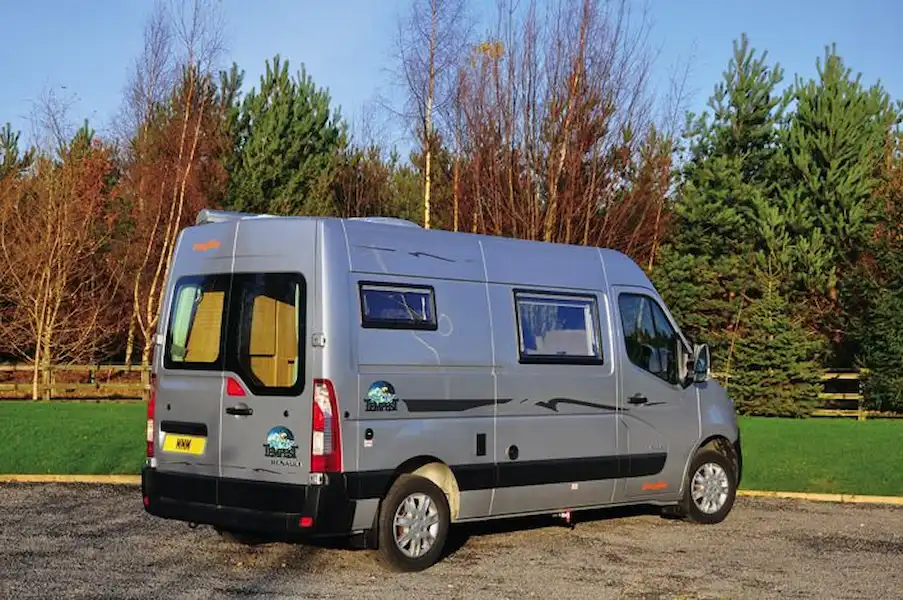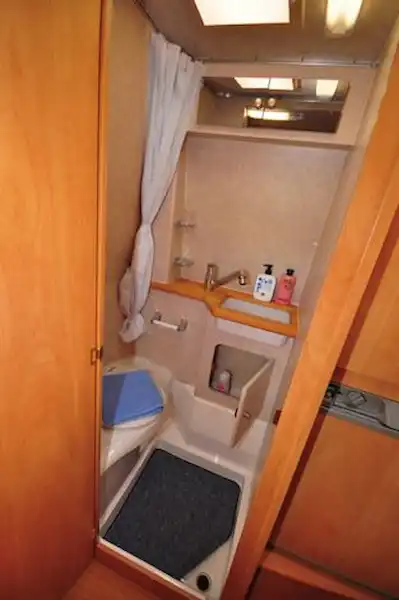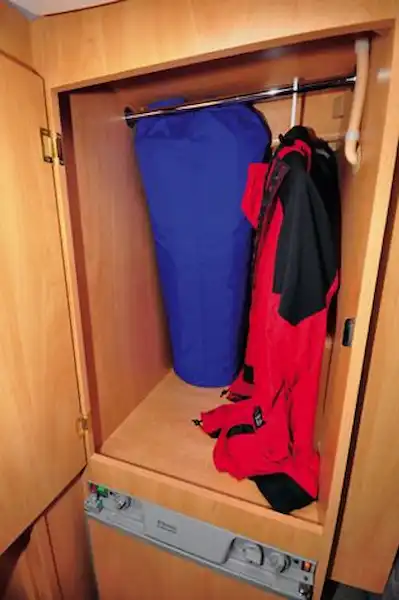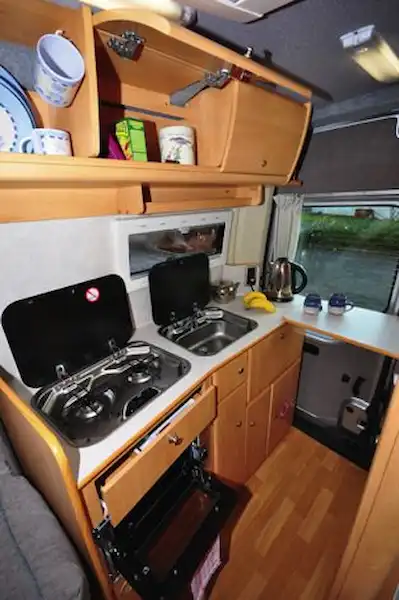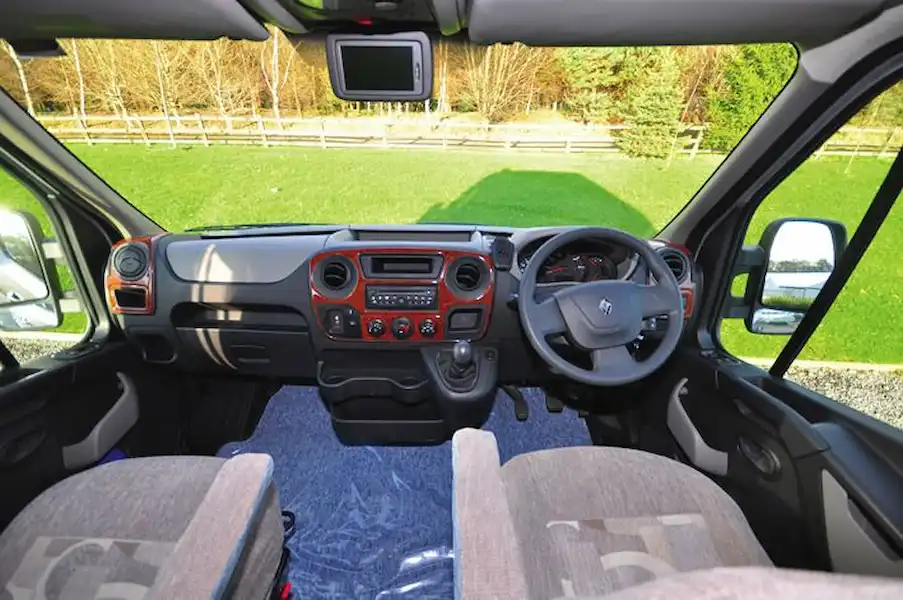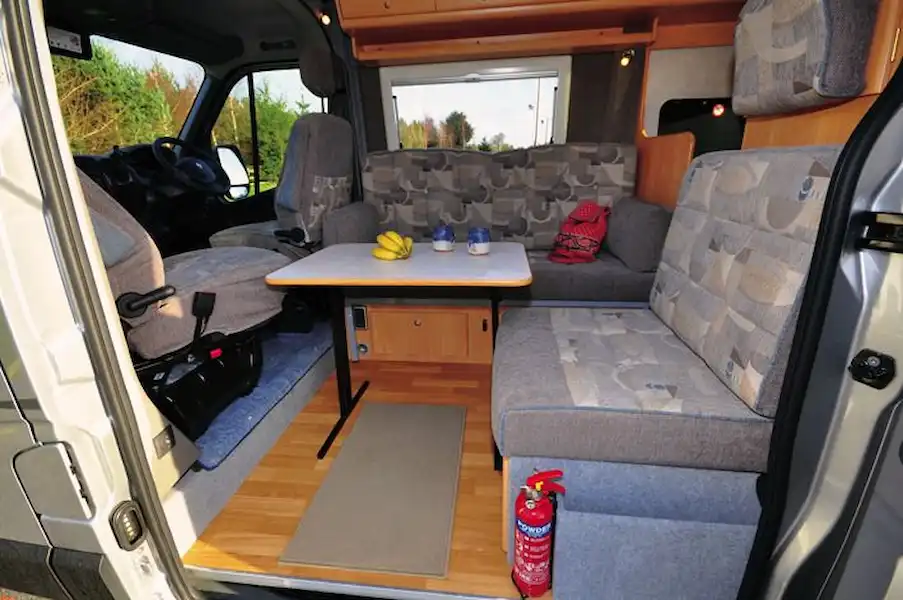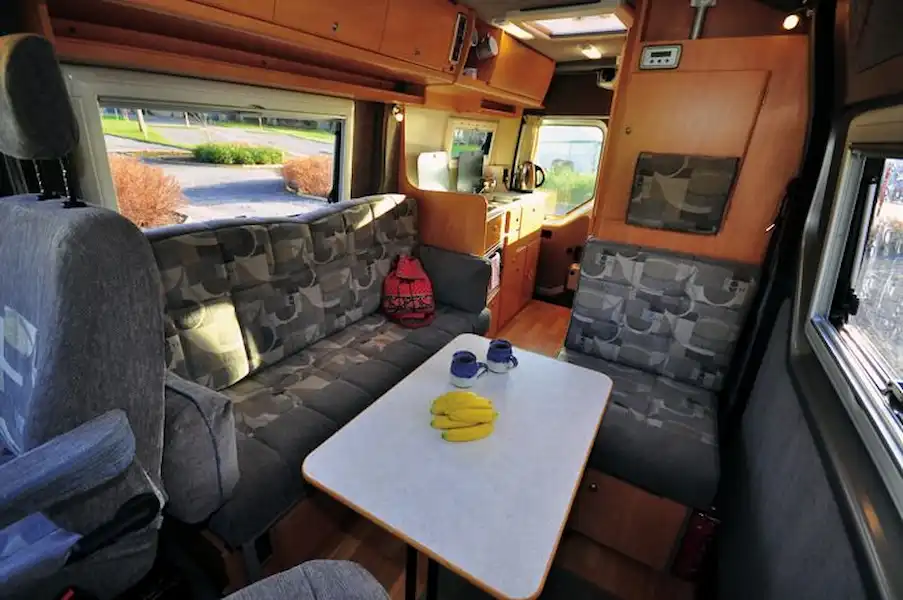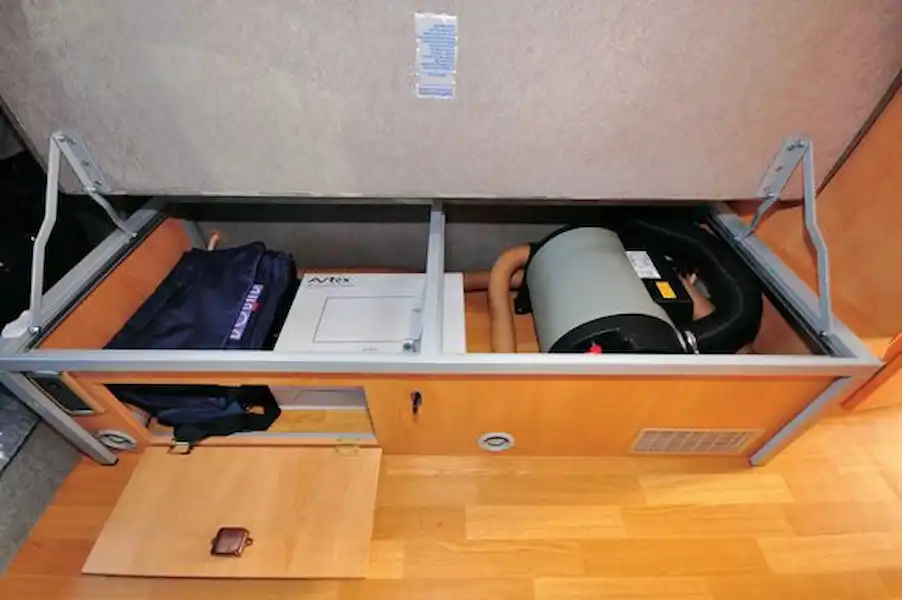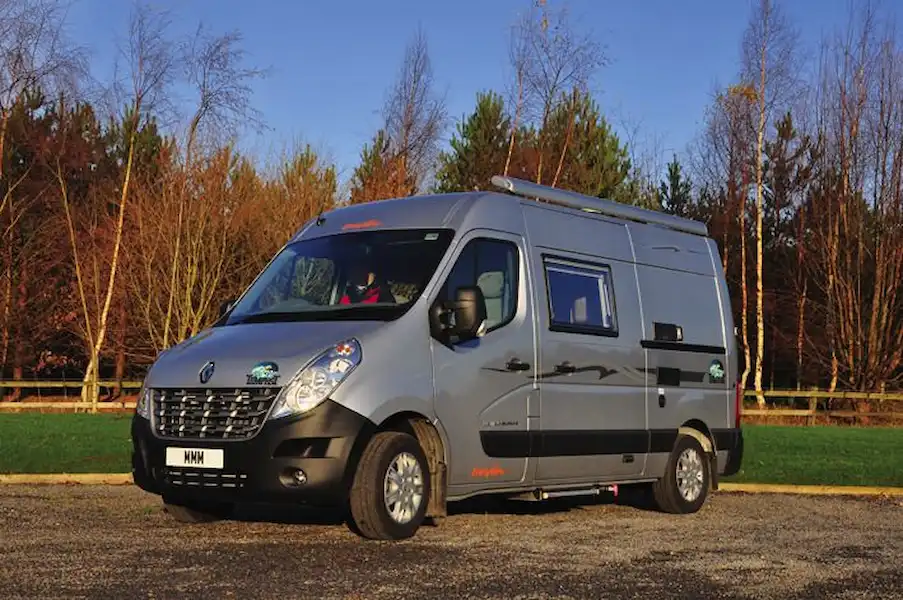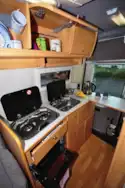Key Features
| Model Year | 2012 |
| Class | High top |
| Base Vehicle | Renault Master |
| Price From (£) | 39,941 |
| Length (m) | 5.54 |
| Berths | 2 |
| Belted Seats | 3 |
| Main Layout | Front Lounge |
At a glance
Full review
Devon’s latest compact high top offers good accommodation in a small space...Devon Conversions is confusingly, not based in Devon, but at the other end of the country in Ferryhill, County Durham. The firm converts on many of the light commercial vehicles available in Britain: Mercedes-based Sapphires, the acclaimed Aztec series on Fiats or Citroëns and the VW T5-based Sundowner and Moonraker. In the past, Toyota Hiace, Ford Transit, LDV Sherpa and Iveco Daily were also used.
Mastering the Renault
For quite a while Devon has been one of the few British companies converting Renault’s Master and, with the advent of the new model in 2010, the range has been revised to utilise this new version. The Monte Carlo name remains for long wheelbase motorhomes, but both the Limousin and Camargue medium wheelbase models are replaced by the new Tempest, which comes with two, three or four-seater versions, all front lounge-based layouts.
All Masters now have 2.3-litre engines, with outputs of 100, 125 and 150 horsepower. Front or rear-wheel drive variants are available, and the range comprises short, medium, long or extra long versions.
Based on the medium wheelbase model, the Tempest is a handy 5.55 metres (18ft 2.5in) long and though a smidge wider than the Sevel-built (Fiat Ducato/Citroën Relay/ Peugeot Boxer) opposition, it doesn’t look or feel it on the road. Here, it has a 125bhp, Euro 5-compliant motor, front-wheel drive, a manual six-speed gearbox and came in silver. Along with dark slate blue, this is a stock colour for Devon, but any standard Renault colour can be specified (metallic paint is a cost option). Nautically-themed roundel graphics depict a sailing ship on stormy seas and side decals suggest a flowing wave, while the traditional orange Devon insignia highlights prow, stern and sides. Actually, all is very restrained, producing a slightly anonymous looking, modestly-sized motorhome.
Externally, the most outstanding feature is the enormous radiator grille common to all new Masters. The three-seater variant test vehicle had optional TV aerial, electric omnistep, colourmatched awning and reversing sensors fitted, taking the 2012 on-the-road price from the basic £39,941 to £43,783. This is quite a jump up from last year’s figure, but around the current market norm for a well-specified panel van conversion.
IN THE CAB
The latest Master cab is greatly improved compared to the previous model and comes with a vast number of cubbies. TomTom sat nav, fitted as standard by Renault here, replaces the interior mirror – not a problem, as the electrically-adjustable door mirrors are excellent. All-round visibility is super, helped by slim A-pillars and a high seating position.
The old flat ‘bus-style’ steering wheel has gone and, though it only adjusts for rake, a comfortable driving position should be easily achievable. The dash-mounted gearlever fell readily to hand, instruments proved clear and informative, while an otherwise rather dull grey dashboard is rendered more, err, dashing by a wood-effect insert. The handbrake, positioned centrally, could foul a swivelling driver’s seat, but it’s not a problem in this Tempest as only the cab passenger seat swivels.
ON THE ROAD
Compared to Fiats and other Sevels – which most motorhomes are currently based on – the new Master has lighter, somewhat less precise steering and softer suspension, so feels less sporty. This isn’t a criticism, as it encourages a more relaxed driving style that’s arguably more appropriate to a leisure vehicle. Moreover, throttle response is progressive, the van reverses smoothly and has a good turning circle for its size. It’s quiet too – both mechanically and from interior fittings. I’ve found some Master-based ’vans with the 125bhp engine a little lacking in punch (probably due to the tightness of extreme youth), but not this one – it was very sprightly, even though new.
Whilst at Devon’s Ferryhill factory, I took the opportunity to drive a smart, dark-blue, fourseater Tempest, fitted with the Quickshift six-speed auto gearbox, which can be had for a reasonable £960 extra. You can drive in fully automatic mode or, after nudging the lever sideways, change manually. With no clutch pedal to worry about you simply push the gearlever to change up, pull it to change down. Should you forget you’re in manual mode and approach a junction in too high a gear, the automatic gearbox quietly takes over and changes down appropriately. It’s a great system, which is proving popular.
IN THE LOUNGE
All Tempests have a front lounge, accessed through the side sliding door. There are three alternative layouts: the four-seater has two forward-facing rear travel seats, the three-seater replaces one rear seat with an inward-facing settee. Finally, the two-seater sees the other rear seat replaced by an additional storage unit. The three-seater test vehicle’s interior décor featured blue-grey/beige patterned upholstery and grey fabric on the walls. Blue carpet graced the cab, with wood-plank-effect vinyl flooring aft. Warm mid-toned woodwork is partnered with pleasing grey/beige marble-effect worksurfaces.
The Quickshift-equipped ’van had more cheerful (we thought) beige upholstery, with red piping and brighter wall-covering. Lounge lighting is provided by four cornermounted, adjustable LED reading lamps, augmented by two ceiling-mounted fluorescent strips. An extra Heki would be nice here, as the rooflight above the kitchen is a bit far away. There are no curtains, save for on the rear doors. Seitz concertina blinds are provided for lounge and kitchen windows, with insulated screens for the cab.
As the Master’s cab floor is considerably higher than that in the rest of the interior, the passenger cab seat is best swivelled sideways so feet can rest on the (extended) cab floor. Try facing the rear (maybe to watch television) and even the longest legs would dangle. The (optional) Avtex TV, mounted on an adjustable wall bracket, has a dedicated cupboard behind the travel seat. It’s best viewed from the settee, and lounging comfort can be improved by sliding the base forward a notch, thus allowing a reclined backrest.
A hefty free-standing table stores between the washroom’s rear wall and the nearside back door. Unfortunately, it’s inextricable without opening the doors, as the position of its retaining catches prevents extraction. However,
this could easily be modified. In practice, the table is only usable from the travel seat and settee, the swivelled cab seat squab being level with, or above, the table top.
IN THE KITCHEN
Situated along the offside rear, the kitchen has generous workspace. Practical features include side and rear splash-backs and a useful dropdown extension that spans the aisle. Two glass lids cover (to the left) a Smev twoburner gas hob with electronic ignition and (to the right) a deep rectangular stainless steel sink with mixer tap. Regrettably there’s no integral drainer – Devon suggests employing a tray. Below the hob is a Smev combi oven/grill and the fridge is opposite, under the wardrobe. Unusually, and helpfully, purchasers can choose either a Waeco compressor-type or a Dometic three-way model (loyalties to fridge types are often polarised within the motorhome fraternity). This Tempest had the Dometic model, with small freezer compartment and modest 60-litre capacity.
There’s an impressive amount of storage space in here, with cupboards under the cooker, the sink and below the rear worktop, where the drop-down front reveals a space, probably large enough for a microwave. The large cutlery drawer is a welcome feature, though low sides reduce its potential capacity. Overhead are two unshelved cupboards with curved doors – one can’t be opened fully though, as it’s obstructed by one of the two ceiling strip-lights. And it also fouls the washroom door slightly when both are opened. Alongside, is another, open-fronted cupboard containing the crockery set provided by Devon.
We’d prefer crockery to be safely retained behind a door. A narrow, lipped shelf runs beneath the overhead cupboards, and there’s a corner shelf with fiddle rail. Though lacking a striplight under the overhead lockers (which would be useful), the nearest lounge reading light swivels to help illuminate the hob.
TIME FOR BED
This three-seater Tempest provides just a transverse double bed (four-seaters have twin singles). You start bed making by releasing spring latches and sliding forward the travelseat base, topping it with three flat cushions. The settee base pulls across the aisle, the seatback dropping flat behind to reveal two fabric-lined recesses in the offside wall. The length (across the ’van) of the resultant mattress is just 1.70m (5ft 7in), but the full, wall-to-wall length available for stretching out, including the recesses, is 1.90m (6ft 3in).
The bed’s width is generous at 1.53m (5ft 0.5in). For tall folk like me, this bed configuration is rather short, so make sure you try before you buy. Two fabric-covered boards can be slotted into the rear of the cab seat bases – the intention to allow longitudinal sleeping, when used with some extra cushions. In reality, these beds are shorter than the transverse bed, so boards and extra cushions might be best left at home.
WASHROOM
The washroom, located opposite the kitchen, is compact, but contains all necessities. The bench-type loo is Thetford’s excellent 402C, with its own flush water supply and, to avoid cutting unnecessary holes in the vehicle’s side, the (wheeled) cassette is removed into the aisle. Because there’s a structural cross-beam above the rear doors, the top section of the washroom’s back wall is angled forwards, reducing space here for tall me. There’s a fixed rectangular washbasin within a wooden surface – the mixer tap doubling as the showerhead, though there’s
no wall bracket or riser bar.
The floor comprises a rectangular shower tray (with mat), its drain hole in the correct place – the inboard front corner. There’s no window, but a rooflight and ceiling-mounted strip-light illuminate reasonably enough. The full complement of toilet-roll holder, toothbrush mug and holder, soap dish, shower curtain and towel-ring is fitted. Cupboard storage lurks below the washbasin. There’s a slim cupboard, with mirrored, sharp-edged doors just at head height over the basin – baldies beware!
STORAGE
The Tempest has a hefty payload of 615kg, even including the standard-fit spare wheel and pleasingly, adequate space in which to test it. The wardrobe, located above the fridge, isn’t huge, having a hanging drop of just 820mm. However, there’s also a floor-level cupboard below the fridge, and space under the rear travel seat (accessed from the front). In the forward part of the settee base is a drop-down flap and you can, with some difficulty, raise the settee base to give top access too. The rear of this space is occupied by the Truma Combi boiler, but the front is clear for storage.
The overcab shelf is very slim and of limited capacity, while above the settee are three unshelved lockers, with a lipped shelf (too narrow for paperbacks when travelling) below. There’s a magazine box on the side of the travel seat, a slim shelf within the TV cupboard and fabric pockets on the back of the cab seats.
EQUIPMENT
The Tempest has a beefy 110 amp hr battery, located in a cupboard below the cooker and – an excellent feature – an externally-filled 11kg Gaslow cylinder in a rear cupboard. The water tanks are both underslung, fresh and waste water tanks holding 82 and 41 litres respectively. Twin airbags are standard, but cab air-conditioning is part of the Designer Pack, along with rather smart alloy wheels, reversing sensors and fog lights. At £1,500, I’d expect most people to choose this.
CONCLUSION
Even though most manufacturers choose long wheelbase panel vans for conversion, there’s still a keen market for compact, more easily parked motorhomes. This is the Tempest’s niche. Personally, we’d like a longer bed, but to many folk, that won’t matter. They’ll also be attracted by the Tempest’s solid construction and well-designed layout. The long-standing reputation of Devon Conversions and the latest Renault Master, with its reasonably-priced auto gearbox option, should also be draws.
For those living in the south of England (for whom a trek up to Ferryhill might seem too far), it’s worth noting that Devon ’vans are also available through Hampshire & Dorset Motorcaravans.
To read the full motorhome review in PDF format exactly as it appeared in the February 2012 issue of MMM click here
If you don't already have Adode Acrobat to be able to open a PDF, download it for free



Expert motorhome advice to your door!
Why not subscribe to one of our fabulous magazines and get expert advice, travel ideas, technical help and all the latest news for your motorhome and your motorhome adventures!
Want to know more about MMM magazine?
Every month MMM has articles written by motorhomers who have been there and done it, from great UK and European (and further afield) tours, campsite reviews, owners' reports and DIY projects among other things. MMM's tests, reviews and expert buying guides are not to be missed. MMM's technical advice is a must and includes everything from weekend jobs to longer-term DIY projects. And much more!
About MMM magazineWant to know more about What Motorhome magazine?
Every issue of What Motorhome magazine provides essential buying advice for anyone looking to buy a new motorhome or campervan or upgrade their existing model. With a pedigree of over 30 years of offering the best motorhome and campervan buying advice, every issue of What Motorhome includes more new motorhome and campervan reviews than you will find in any other magazine.
About What MotorhomeWant to know more about Campervan magazine?
Campervan is the exciting monthly magazine that will give you all the inspiration you need to explore the world in your campervan. Every issue is packed with real-life campervanning experiences, inspiring travel ideas in the UK and further afield, the best campsites to stay on, campervan road tests and reviews of the latest models, and much more!
About Campervan magazine

